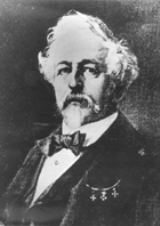
Ascanio Sobrero
Encyclopedia
Ascanio Sobrero was an Italian
chemist
, born in Casale Monferrato
. He was studying under Théophile-Jules Pelouze
at the University of Turin
, who had worked with the explosive material guncotton.
He studied medicine in Turin and Paris and then chemistry at the University of Gießen with Justus Liebig, and earned his doctorate in 1832. In 1845 he became professor at the University of Turin
During his research he discovered nitroglycerine. He initially called it "pyroglycerine", and warned vigorously against its use in his private letters and in a journal article, stating that it was extremely dangerous and impossible to handle. In fact, he was so frightened by what he created that he kept it a secret for over a year.
Another of Pelouze's students was the young Alfred Nobel
, who returned to the Nobel family's defunct armaments factory and began experimenting with the material around 1860; it did, indeed prove to be very difficult to discover how to handle it safely. In the 1860s Nobel received several patents around the world for mixtures, devices and manufacturing methods based on the explosive power of nitroglycerine, eventually leading to the invention of dynamite
, ballistite
and gelignite
from which he made a fortune.
Although Nobel always acknowledged and honored Sobrero as the man who had discovered nitroglycerine, Sobrero was not only dismayed by the uses to which the explosive had been put, but also on occasion claimed that he was not given sufficient recognition.
Italy
Italy , officially the Italian Republic languages]] under the European Charter for Regional or Minority Languages. In each of these, Italy's official name is as follows:;;;;;;;;), is a unitary parliamentary republic in South-Central Europe. To the north it borders France, Switzerland, Austria and...
chemist
Chemist
A chemist is a scientist trained in the study of chemistry. Chemists study the composition of matter and its properties such as density and acidity. Chemists carefully describe the properties they study in terms of quantities, with detail on the level of molecules and their component atoms...
, born in Casale Monferrato
Casale Monferrato
Casale Monferrato, population 36,058, is a town and comune in the Piedmont region of north-west Italy, part of the province of Alessandria. It is situated about 60 km east of Turin on the right bank of the Po, where the river runs at the foot of the Montferrato hills. Beyond the river lies the...
. He was studying under Théophile-Jules Pelouze
Théophile-Jules Pelouze
Théophile-Jules Pelouze was a French chemist. He was born at Valognes, and died in Paris....
at the University of Turin
University of Turin
The University of Turin is a university in the city of Turin in the Piedmont region of north-western Italy...
, who had worked with the explosive material guncotton.
He studied medicine in Turin and Paris and then chemistry at the University of Gießen with Justus Liebig, and earned his doctorate in 1832. In 1845 he became professor at the University of Turin
University of Turin
The University of Turin is a university in the city of Turin in the Piedmont region of north-western Italy...
During his research he discovered nitroglycerine. He initially called it "pyroglycerine", and warned vigorously against its use in his private letters and in a journal article, stating that it was extremely dangerous and impossible to handle. In fact, he was so frightened by what he created that he kept it a secret for over a year.
Another of Pelouze's students was the young Alfred Nobel
Alfred Nobel
Alfred Bernhard Nobel was a Swedish chemist, engineer, innovator, and armaments manufacturer. He is the inventor of dynamite. Nobel also owned Bofors, which he had redirected from its previous role as primarily an iron and steel producer to a major manufacturer of cannon and other armaments...
, who returned to the Nobel family's defunct armaments factory and began experimenting with the material around 1860; it did, indeed prove to be very difficult to discover how to handle it safely. In the 1860s Nobel received several patents around the world for mixtures, devices and manufacturing methods based on the explosive power of nitroglycerine, eventually leading to the invention of dynamite
Dynamite
Dynamite is an explosive material based on nitroglycerin, initially using diatomaceous earth , or another absorbent substance such as powdered shells, clay, sawdust, or wood pulp. Dynamites using organic materials such as sawdust are less stable and such use has been generally discontinued...
, ballistite
Ballistite
Ballistite is a smokeless propellant made from two high explosives, nitrocellulose and nitroglycerine. It was developed and patented by Alfred Nobel in the late 19th century.-The development of smokeless powders:...
and gelignite
Gelignite
Gelignite, also known as blasting gelatin or simply jelly, is an explosive material consisting of collodion-cotton dissolved in either nitroglycerine or nitroglycol and mixed with wood pulp and saltpetre .It was invented in 1875 by Alfred Nobel, who had earlier invented dynamite...
from which he made a fortune.
Although Nobel always acknowledged and honored Sobrero as the man who had discovered nitroglycerine, Sobrero was not only dismayed by the uses to which the explosive had been put, but also on occasion claimed that he was not given sufficient recognition.

